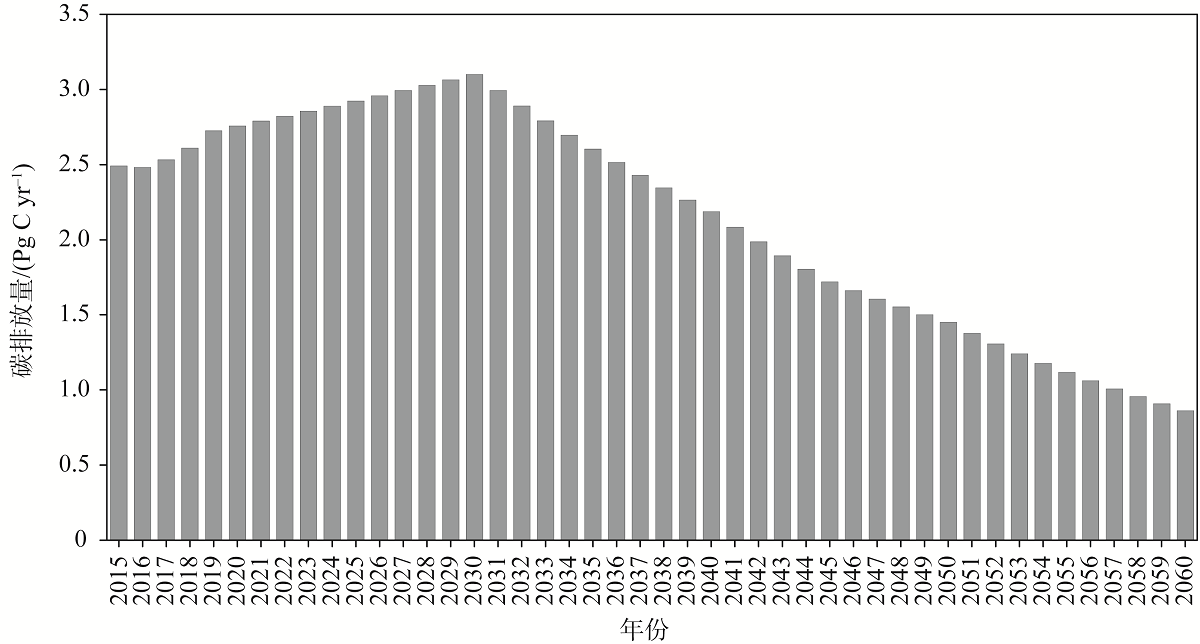

面向碳中和的中国低碳国土开发利用
|
黄贤金(1968- ),男,江苏扬中人,博士,教授,研究方向为土地利用与政策、国土空间规划及自然资源管理等。E-mail: hxj369@nju.edu.cn |
收稿日期: 2021-02-08
修回日期: 2021-06-04
网络出版日期: 2022-02-28
基金资助
国家社会科学基金重大项目(17ZDA061)
自然资源部研究项目(0904/133047)
自然资源部研究项目(2021005)
江苏省国土资源研究中心(智库)开放合作项目(202109)
版权
Land development and utilization for carbon neutralization
Received date: 2021-02-08
Revised date: 2021-06-04
Online published: 2022-02-28
Copyright
基于IPAT和IBIS模型在预测人为碳排放和陆地生态系统碳汇的基础上,探讨了中国2060年实现碳中和的可行性以及不同土地利用方式承载的碳汇分布。2060年我国人为碳排放预计为0.86 Pg C yr -1;IPCC报告中RCP 2.6和RCP 6.0情景的陆地生态系统分别中和33%和38%的人为碳排放。2060年林地、草地、耕地是陆地生态系统碳汇主要贡献者,占93%;与2030年比,在RCP 2.6情景下林地和草地的碳汇贡献分别下降10%和8%,而耕地上升18%;RCP 6.0情景下林地和草地的贡献分别下降7%和2%,而耕地上升4%。但若按2051—2060年间两种情景下的最高年份(2055年)的碳汇计,则分别可以中和65%、82%的人为碳排放。据此,提出为实现2060年碳中和,应以碳承载力为基础,聚焦区域国土空间规划和建设用地开发规模,对土地利用转变进行严格管控,探索制订土地利用碳排放标准。

黄贤金 , 张秀英 , 卢学鹤 , 王佩玉 , 秦佳遥 , 蒋昀辰 , 刘泽淼 , 汪振 , 朱阿兴 . 面向碳中和的中国低碳国土开发利用[J]. 自然资源学报, 2021 , 36(12) : 2995 -3006 . DOI: 10.31497/zrzyxb.20211201
This study explores the possibility of carbon neutralization in China before 2060, based on the predicated carbon emissions from human activities and the carbon sinks produced by the territory ecosystem. The results show that the total anthropogenic carbon emissions in China is 0.86 Pg C yr -1 in 2060, and the ecosystem would neutralize 33% and 38% of the anthropogenic CO2 emissions in 2060 under the scenarios of IPCC RCP 2.6 and RCP 6.0. In 2060, woodland, grassland and cultivated land will be the main contributors of carbon sink, accounting for 93% of the total carbon sink. Compared with the year 2030, the contribution of carbon sink from woodland and grassland will decrease by 10% and 8%, respectively under RCP 2.6 scenario, while the contribution from cultivated land will increase by 18%; the contribution of carbon sink from woodland and grassland will decrease by 7% and 2%, respectively under RCP 6.0 scenario, while the contribution from cultivated land will increase by 4%. However, based on the highest carbon sink (2055) during 2051-2060, 65% and 82% of anthropogenic carbon emissions would be neutralized respectively. Therefore, to achieve carbon neutrality in 2060, the varieties of the bearing capacities of carbon budgets from different land use types should be fully considered in the territory planning.

| [1] |
刘玫, 李鹏程. 气候中性与碳中和国际实践及标准化发展对我国的启示. 标准科学, 2020,8(12):121-126.
[
|
| [2] |
《中国能源》编辑部. 为力争二氧化碳排放于2030年前达到峰值, 努力争取2060年前实现碳中和而奋斗. 中国能源, 2020,2(10):42.
[ Editorial Department of Energy of China. Striving for the peak of carbon dioxide emissions by 2030 and carbon neutrality by 2060. Energy of China, 2020,2(10):42.]
|
| [3] |
田成诗, 陈雨. 中国省际农业碳排放测算及低碳化水平评价: 基于衍生指标与TOPSIS法的运用. 自然资源学报, 2021,36(2):395-410.
[
|
| [4] |
田华征, 马丽. 中国工业碳排放强度变化的结构因素解析. 自然资源学报, 2020,35(3):639-653.
[
|
| [5] |
|
| [6] |
|
| [7] |
张煜星, 王雪军. 全国森林蓄积生物量模型建立和碳变化研究. 中国科学: 生命科学, 2021,51(2):199-124.
[
|
| [8] |
李克让. 土地利用变化和温室气体净排放与陆地生态系统碳循环. 北京: 科学出版社, 2002: 5-100.
[
|
| [9] |
|
| [10] |
黄征学. 从土地资源管理视角求解碳中和. 中国自然资源报, 2021-04-05.
[
|
| [11] |
刘立涛, 刘晓洁, 伦飞, 等. 全球气候变化下的中国粮食安全问题研究. 自然资源学报, 2018,33(6):927-939.
[
|
| [12] |
吕炜. 美国产业结构演变的动因与机制: 基于面板数据的实证分析. 经济学动态, 2010,50(8):131-135.
[
|
| [13] |
杜强, 陈乔, 陆宁. 基于改进IPAT模型的中国未来碳排放预测. 环境科学学报, 2012,32(9):2294-2302.
[
|
| [14] |
姜克隽, 胡秀莲, 庄幸. 中国2050年低碳情景和低碳发展之路. 中外能源, 2009,14(6):1-7.
[
|
| [15] |
IPCC. Climate Change 2013: The Physical Science Basis. http://climatechange2013.org/2014.
|
| [16] |
|
| [17] |
朱求安, 江洪, 刘金勋. 基于IBIS模型的1955—2006年中国土壤温度模拟及时空演变分析. 地理科学, 2010,30(3):355-362.
[
|
| [18] |
卢学鹤. 氮沉降对全球陆地生态系统碳收支影响的IBIS模型模拟. 南京: 南京大学, 2014.
[
|
| [19] |
|
| [20] |
|
| [21] |
|
| [22] |
|
| [23] |
|
| [24] |
|
| [25] |
林伯强. 2060 年中国“碳中和”目标的路径、机遇与挑战. 第一财经日报, 2020-11-19(A11).
[
|
| [26] |
杨延征, 马元丹, 江洪, 等. 基于IBIS模型的1960—2006年中国陆地生态系统碳收支格局研究. 生态学报, 2016,36(13):3911-3922.
[
|
| [27] |
翁睿, 韩博, 孙瑞, 等. 国际生态修复理念与方法对我国新时期国土综合整治的启示. 土地经济研究, 2020,6(1):117-140.
[
|
| [28] |
赖力, 黄贤金. 中国土地利用的碳排放效应研究. 南京: 南京大学出版社, 2011: 169-174.
[
|
| [29] |
徐晓晔, 黄贤金. 基于碳排放峰值的长江经济带人口承载力研究. 现代城市研究, 2016,30(5):33-38.
[
|
/
| 〈 |
|
〉 |